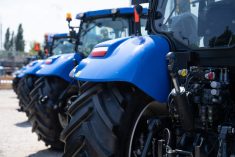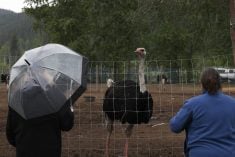GRISWOLD, Man. — Stan Cochrane wasn’t particularly angry or dejected as he looked out at a lake covering a field of canola stubble on his farm.
Cochrane’s emotional reaction was almost mute because he’s witnessed this scene many times before. Overflow from the Assiniboine River flooded his farm in 2010, 2011 and 2012.
Cochrane is frustrated and tired of provincial inaction when it comes to Assiniboine River flooding.
“We need a government that starts working with Saskatchewan and saying, ‘listen you guys, you’ve drained a million acres of land and you’re producing crops on that land. You’ve taken 50,000 acres of land in Manitoba out of production. So, what are you (Saskatchewan) going to do about it?’ “
Read Also

Arlene Dickinson says recent trip to Asia opened her eyes to new trade opportunities
Arlene Dickinson says Canada must take up decades-old suggestions to support the agriculture and food sectors
Cochrane and his children, who now run the mixed farm 35 kilometres west of Brandon, will lose 1,500 acres of cropland this year to Assiniboine River flooding.
The Cochranes are just one of many family farms in the Assiniboine River Valley, between Brandon and Russell, who are affected by flooding this spring.
Cochrane estimated overflow from the Assiniboine will hit 75 to 100 farms and put 50,000 acres of cropland out of production.
In an early May flood bulletin, the province said high flows on the Assiniboine has flooded 30,000 acres of agricultural land between the Shellmouth Dam and Brandon.
On a 5 C morning in mid-May, spillover from the Assiniboine River covered most of a canola field on the Cochrane farm. The water began 1.25 km south of the farm, at the normal banks of the river, and stopped 50 m from the farmhouse.
This year’s flood was a surprise. Provincial flood forecasters said in February and March that the risk of spring flooding was minimal because snowfall and soil moisture in the Assiniboine River basin was normal or below normal.
Manitoba Infrastructure and Transportation operates water control structures in the province, including the Shellmouth Dam near the Saskatchewan border. It is the primary reservoir on the Assiniboine.
Cochrane said the government didn’t lower the reservoir’s water level sufficiently this spring. When a torrent of water from Saskatchewan flowed into the Shellmouth in April, the reservoir overflowed and flooded landowners downstream.
Cochrane, who sits on the liaison board for the operation of the Shellmouth Dam, said Manitoba flood forecasters don’t account for the incredible amount of drainage projects that Saskatchewan producers have built on their farmland over the last decade.
“They’re admitting drainage is a problem, but they can’t figure out how big of a problem,” said Cochrane, chair of the Assiniboine Valley Producers Association.
“I said (during) one of the (recent) conference calls, ‘you guys should get in an airplane and see where this water is coming from.’ “
Manitoba Infrastructure and Transportation didn’t provide comment before the deadline for this story.
Keystone Agricultural Producers vice-president Dan Maier said a group of concerned Manitobans is working on a solution to flooding and other water issues within the Assiniboine River basin.
The Prairie Improvement Network (PIN), formerly the Manitoba Rural Adaptation Council, held a workshop this spring in Virden, Man., to discuss the potential of an Assiniboine River basin initiative. PIN wanted to know if municipal representatives, conservation organizations, academics and agricultural groups from Saskatchewan, North Dakota and Manitoba were willing to work together on this matter.
“We really asked the residents of the basin … ‘do you think working on a basin wide approach is the right way to go?’ ” said Mazier, who farms north of Brandon.
“At that meeting, we heard a resounding ‘yes.’ “
Mazier said they plan to hold another meeting in the fall to decide who will lead the organization and how it will function.
Cochrane said the concept is solid but it could take years to develop a commission for the Assiniboine River basin.
“It’s far too slow for me,” he said.
“If we were really serious about it, we should (be) meeting again in a month.”
Cochrane said there are options to mitigate flooding downstream of the Shellmouth Dam, such as building small dams or dredging a section of the river.
The government is spending hundreds of millions to build a permanent channel between Lake Manitoba and Lake Winnipeg to keep water elevations on Lake Manitoba below flood levels.
Cochrane said the province doesn’t have the same desire, or willingness, to deal with the Assiniboine River in western Manitoba.
“We want to figure out how to control the water so we can farm (the land),” Cochrane said.
“I had several meetings at the winter fair with (agriculture) Minister Kostyshyn. His only way of solving the problem is buying the land. Buy the land and let them flood it every year.”















